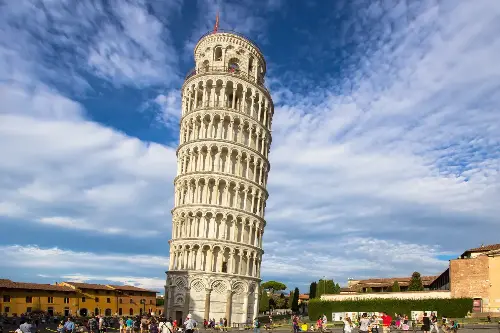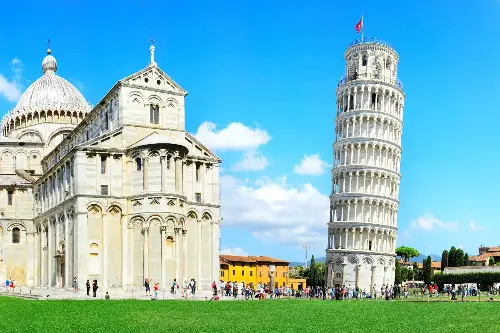Looming with grandeur and a curious inclination that has captured imaginations for centuries, the Leaning Tower of Pisa stands as a testament to both human ingenuity and the importance of sound engineering principles. Nestled in the Piazza dei Miracoli (Square of Miracles) in the Italian city of Pisa, this peculiar tower has transcended its architectural mishap to become one of the world's most recognized structures and a symbol of Italy’s rich artistic and cultural heritage.

The Tower of Pisa, or simply the Tower, began its journey skyward in the summer of 1173, envisaged as the bell tower for the adjacent cathedral, itself an imposing structure. Architects and builders of the Middle Ages embarked on this daring project, but little did they know that the very ground they chose was a fluctuating mixture of clay, fine sand, and shells. This unstable foundation—posing no immediate concern to the initial construction—would give rise to the tower's distinctive tilt, manifesting within the first few years of construction and abruptly halting progress as the tower reached its third storey.
Work on the tower resumed nearly a century later, and the architects attempted to compensate for the tilt by adding additional floors with one side slightly taller than the other. This attempt to achieve vertical perfection only added to the tower’s inclination, yet through a combination of ingenuity and determination, the tower was completed in the mid-14th century, standing tall with its unintended and iconic lean.
The Leaning Tower of Pisa is an embodiment of various architectural styles, with classical arches and genuine Gothic elements, hinting at the transition period it was built over. Its eight stories are adorned with intricate carvings and columns that reflect the artistic tendencies of the era. At the very top, the belfry houses seven bells, each harmonized to a musical scale. They are rarely rung due to concerns that the vibrations could exacerbate the tilt.

Contrary to popular mythology, Galileo Galilei did not drop two cannonballs of different masses from the tower to demonstrate that their time of descent was independent of their mass. However, the tower does bear relevance to Galileo's life; as a native of Pisa, it is believed that he conducted experiments on pendulum motion within the confines of the cathedral complex.
The lean, once increasing, has now been brought to a stop thanks to 21st-century engineering. After the tower's closure in 1990 due to safety concerns, a multinational team of engineers, historians, and soil experts collaborated on an extensive restoration and stabilization effort. Through the fortunate mixture of old records, modern computer simulations, and laborious groundwork—which included the removal of earth from underneath the foundation and the addition of lead counterweights—the Leaning Tower of Pisa was secured, and its lean was reduced by about 45 centimeters, returning it to the angle it held in the early 19th century.
Currently, this architectural marvel leans at about 3.97 degrees, down from the precarious 5.5 degrees before the stabilization. Yet, it is this very imperfection that lures tourists from around the globe. Climbing the tower’s 294 steps rewards visitors with a slightly tilted perspective of Pisa and breath-taking views of the Tuscan landscape. This experience, combined with the allure of capturing the quintessential shot of pretending to prop-up or push down the tower, ensures a continuous flow of tourists to the site.

The Leaning Tower of Pisa offers a compelling narrative about the evolution of architectural practices, the unforeseen consequences of building on a weak subsoil foundation, and the ongoing commitment to preserving history. Furthermore, its survival through numerous wars, earthquakes, and the passage of over eight centuries is a tribute to the builders who, inadvertently perhaps, erected a structure that would far outlive their own expectations.
The Leaning Tower of Pisa is not just an architectural marvel; it is a cultural icon that captures the human spirit in its insatiable quest for beauty, perfection, and the indomitable will to fix our mistakes. It embodies resilience, a reminder that even flawed creations can withstand the test of time and become cherished across the globe.
Whether seen as a symbol of human error or an icon of architectural resilience, the Leaning Tower of Pisa continues to stand with strength and elegance, leaning gracefully into its legacy while securing its place as one of the lasting wonders of the world. It serves not only as a lesson in history and a beacon of aesthetic achievement but also as an eternally compelling story for anyone who gazes upon its leaning silhouette against the Italian sky.
